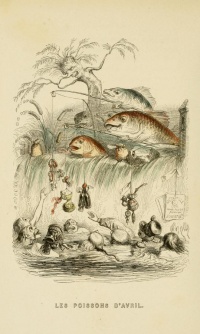
“Les poisson d’avril” by Grandville from Another World
Following yesterday’s post[1] on Un autre monde, I’ve been cleaning up my copy of the full text of that fantastic book and furthering my research on it and Grandville (1803 – 1847) in general.
- Kindred spirits
The only person coming close in sheer absurdity to Grandville in the Anglophone world is Edward Lear (1812 – 1888) of whom I recently posted his Walking Fish[2].
- Charles Baudelaire and Walter Benjamin on Grandville
To my surprise, Baudelaire doesn’t care for Grandville nor his work, literally saying “there are superficial people who find Grandville entertaining; as for me, he scares me.” (translation mine, see Baudelaire on Grandville).
The philosopher Walter Benjamin (1892-1940) saw in Grandville’s drawings, especially in Another World, a glorification of commodity fetishism: “The enthronement of the commodity … is the secret theme of Grandville’s art” and “if the commodity has become a fetish, Grandville is its sorcerer-priest.” (translation mine)
- English translations
There is no public domain translation of the work of Grandville. There is Stanley Appelbaum’s Bizarreries & fantasies of Grandville: 266 illustrations from Un autre monde and Les animaux (Dover Publications, 1974, 1987).
- Commodity fetishism?
Commodity fetishism was of great interest to me in the early 2000s, when I discovered the work of Walter Benjamin. I’m happy to have found a drawing that is proof of Grandville’s status as “sorcerer-priest of commodity fetishism.” The plate is called “Les poisson d’avril” (lit: The April Fishes, but actually French for ‘April Fools’ Day’) [3] in the chapter UN VOYAGE D’AVRIL and depicts fish fishing for humans in an enchanted wood. On their hooks are the commodity fetishes such as “diamants, … croix d’honneur, épaulettes, bourses d’or.” (“diamonds … a cross of honor, epaulettes and gold purses.”).
If you want to browse the on-line version with illustrations, here is the link[4].


